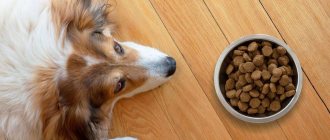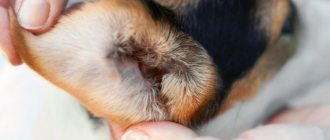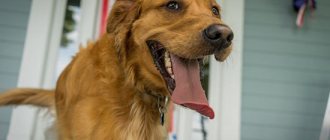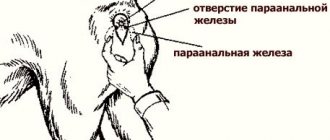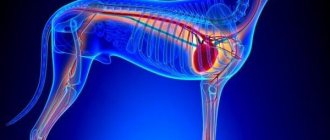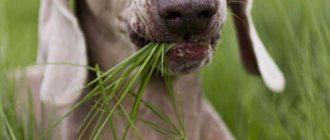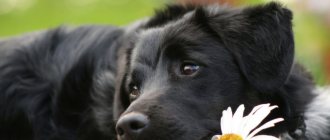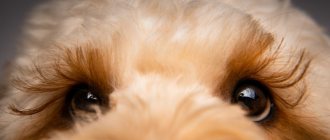The eyeballs of a dog (like other animals) are washed with tear fluid, which is necessary to nourish and moisturize the cornea and remove various contaminants from its surface. All waste moisture should be drained through the nasolacrimal duct. But there are situations when this mechanism is disrupted. The tear fluid does not have time to be drained into the nasal cavity and flows out through the eyelids. In this case, the owner notices two wet grooves on the dog that stretch from the corner of the eyes down the bridge of the nose. The mucous membrane of the eyelids becomes brownish or red, which gives the impression that the pet is crying. From this article you will learn why a dog’s eyes are watery and whether this condition can be treated at home.
Eye diseases and treatment
Here we list the main diseases that cause lacrimation and possible treatment options.
Inversion of the eyelids is the plane of the free edge of the eyelids, which is normally adjacent to the eye, all or in parts turned inward. We observe tearing of the eyes, since with a strong degree of inversion, eyelashes and skin hair come into contact with the cornea, causing its constant irritation, which entails many unpleasant consequences. Treatment is surgery.
Eversion of the eyelids - in this case, the eyes water due to the fact that the lacrimal punctum is no longer immersed in the lake of tears and tears overflow. Because of this, the skin underneath is constantly wet, and this threatens eczema. Complex therapy and surgery are required.
Spasm of the eyelids (blepharospasm) - the dog squints convulsively, blinks frequently, both eyelids are very tense. Under the influence of tears, the skin under the eyes macerates.
Maceration is the loosening, soaking and swelling of the top layer of skin due to prolonged exposure to liquid. Occurs due to external irritation, such as a foreign body. Don't be afraid. The cause of the irritation must be eliminated. Instill 1-3% dicaine solution into the eye, remove the foreign body with tweezers, or rinse it very well with warm water. To reduce pain, use antiseptic ointments with 3% novocaine solution. Painkiller drops can be used, but they have a short-term effect.
Neoplasms of the eyelids.
May be benign: warts, papillomas, fibromas, cysts.
And malignant: sarcomas, melanomas (in individuals with black fur), carcinomas. Under the weight of the tumor, the eyelids droop and the dog blinks slowly. The normal outflow of tear fluid is disrupted, hence lacrimation. Treatment is surgery in the early stages of development.
Neoplasms can be distinguished from other diseases by the following characteristics: rapid growth and painlessness.
Dacryoadenitis is inflammation of the lacrimal gland.
Canaliculitis is inflammation of the tear ducts. With these diseases, profuse lacrimation is observed. With the development of purulent inflammation, you can see that the eye is swollen and pus is released from it; over time, its movement becomes difficult and painful. To treat inflammation, ointments containing an antibiotic (tetracycline ointment) are placed under the eyelids. Coating the palpebral fissure area with 5% camphor ointment or 5% ichthyol ointment also gives a good effect.
Narrowing and blockage of lacrimal canaliculi and points occurs when foreign bodies, neoplasms and other factors enter. It is characterized by constant tearing from the inner corner of the eye or through the entire lower eyelid. There are no signs of inflammation. A course of therapy is only possible in the clinic, as probing of the tubules is required.
Dacryocystitis is inflammation of the lacrimal sac. The affected eye is constantly watery, red and swollen. A liquid similar to egg white is released from the lacrimal openings. All manipulations should be carried out by a veterinarian, since not every person can cope with this. It is necessary to wash the nasolacrimal canal through the nasal opening (with a solution of furatsilin 1: 5000, or 1-2% boric acid). If necessary, surgery is performed to excise the lacrimal sac.
Conjunctival injuries.
The conjunctiva is a membrane that covers the outside and inside of the eyelid.
At the same time, in addition to tearfulness, the dog exhibits photophobia and squints. Often it is not possible to open the eyelids without the use of anesthetic.
Since injuries are accompanied by tissue damage, immediate contact with a veterinarian is required; stitches may be required. The only thing you can do to help is reduce the pain. If possible, drop a 1 - 2% solution of novocaine into your pet's eyes.
Conjunctivitis is inflammation of the conjunctiva. It can be caused by a huge number of reasons that, without treatment, lead to serious consequences. And just one of the first symptoms is discharge from the eyes in the form of tear fluid, to which mucus is then added. Therapy depends on the form of conjunctivitis, which is determined by the doctor. To reduce the amount of discharge, drops of zinc sulfate or silver nitrate are usually prescribed.
In addition to the listed diseases, there are diseases of the sclera, diseases of the cornea (keratitis) and some others, the initial symptom of which is hypersecretion of tear fluid. And by external signs it is impossible to understand what exactly is happening to the eye. Only a veterinary ophthalmologist can reliably determine the disease.
First aid
To determine the cause of tears, the owner must conduct an initial examination of the dog’s eyes himself. This will help him understand how serious the problem is and whether he will need to see a veterinarian. For this:
- Having placed the dog in front of you, you should secure its mouth with a special strap (a muzzle will not work).
- Holding your head, carefully open both eyelids with your fingers and examine the organ of vision for the presence of foreign objects, redness, and clarify the nature of the discharge.
- If a small foreign body or debris gets into the eye, you should carefully remove it and rinse the eye with chamomile decoction, strong tea leaves or warm boiled water. Use a cotton pad soaked in the solution to carefully move from the outer corner of the eye to the inner one. Clean both eyes by changing the cotton pad.
- Such manipulations can be carried out for 5-7 days, after which their effectiveness must be assessed.
- If the leak does not go away, the discharge has become more intense, has changed color, vision has weakened, or the dog’s general condition has become worse, then it is necessary to seek veterinary help.
Other diseases
Unless you clearly see a cause for the tearfulness, such as a foreign body, this symptom may be a sign of a serious condition not related to vision. It can be:
Infectious diseases. For example, with canine distemper, watery eyes and diarrhea are observed.
Allergies. Most often, with food allergies, a dog’s eyes become watery and itchy, and with contact allergies (due to dust, pollen, etc.), in addition to the main symptoms, the dog also sneezes.
It can also be hormonal imbalances and nutritional deficiencies.
Sweets. The canine digestive tract is not designed to absorb glucose - sugar! And disruptions in the digestive tract are primarily reflected in the eyes, hence the tearing.
Consumption of chocolate by your pet can be fatal due to theobromine content, it causes rapid heartbeat, constriction of arteries, and stimulation of the central nervous system.
Causes
Dog owners often visit an ophthalmologist complaining of watery eyes.
Such problems can be caused by various reasons:
- Anatomical structure of the dog’s skull (short or convoluted nasolacrimal duct);
- Blockage and stenosis of the nasolacrimal duct;
- Improperly growing eyelashes (distichiasis, trichiasis);
- Conjunctivitis;
- Changes in the eyelids (inversion, eversion, too long eyelid, improperly developed eyelid, etc.);
- Glaucoma;
- Keratitis of various origins;
- Injuries;
- Allergy.
You need to understand that treating patients with these problems is a necessity. Some of these reasons may cause pain.
Breeds prone to tearing
For representatives of some breeds, watery eyes are a normal phenomenon, due to the peculiarities of their structure. These include brachycephalics (pugs, French and English bulldogs, Pekingese, boxers, sharpeis), dogs with long hair (which often gets in the eyes), and some small dogs, especially Chihuahuas.
Sometimes Bedlington Terrier puppies have excessively watery eyes. The cause may be teething.
The eyes of these breeds require special care. Every morning, remove mucous stains (if this is not done, microbes will develop there). Rinse with a special lotion and wipe with a cotton pad or gauze. You can also rinse with a 0.9% sodium chloride solution or “diamond eyes” drops.
Due to constant tearing of the eyes, so-called crusts may form under them. Normally they can be dark and brownish. There are creams, gels and lotions that are aimed at lightening the hair under the eyes. They do not treat or prevent the disease, they simply eliminate a cosmetic defect.
Why did the spots appear?
If your pug has strange spots on its eyes, you should not hesitate to visit a doctor. The cause of the disease in most cases is pigmentous keratitis. Pugs are susceptible to this disease for a variety of reasons:
- turning of the eyelids;
- trichiasis;
- districhiasis;
- dry eye syndrome;
- lagophthalmos.
Pigmentous keratitis requires intensive treatment under medical supervision. If the disease is left to chance, the dog may go blind or lose an eyeball.
Prevention
Prevention involves daily examination and care of your pet's eyes.
What symptoms should you be wary of:
- The eye waters for a long time;
- The discharge is mucous, dense, thick (not watery);
- Tears are not transparent;
- Smudges are normally brownish, dark, if they are of a different color - pathology;
- The eye is red, swollen, itchy.
To examine the mucous membrane of the eye, place your thumb on the edge of the eyelid and pull it down or up. Normally it is pale pink, moderately moist.
Content optimization
Since a common cause of lacrimation is dry and dusty air, it is necessary to exclude the influence of these negative factors:
- If possible, use a humidifier when turning on the central heating.
- The room should be regularly ventilated, however, avoiding drafts.
- The room should be wet cleaned regularly, avoiding extreme dust. This is especially important in the spring, when there is a lot of tree and flower pollen in the air. This will protect the health of both pets and the owners themselves. In addition, wet cleaning is especially important in urban areas when there is a lot of dust outside, regardless of the time of year.
© shutterstock
What should be in a dog's first aid kit?
For care and treatment in case of damage to your pet’s organ of vision, you need to have the following “eye first aid kit” at home:
Sodium Chloride solution 0.9%. Its composition is closest to the composition of tears, so it is used for cleaning and rinsing.
Eye Drops “Diamond Eyes”. They have a mild anti-inflammatory effect and relieve swelling. Not dangerous, they can be used for daily use.
Tetracycline ointment. Used for inflammation and purulent, mucous discharge.
Before using any products, be sure to consult a specialist.
Tears
Here are some reasons why your pug may be crying and blinking non-stop:
- Keratoconjunctivitis. Inflammation and increased lacrimation are caused by insufficient secretion of eye mucus and drying out of the apples. Treatment is selected by a veterinarian on an individual basis.
- Bringing debris into the eye - during a walk, sand or debris could get into the dog's eye, which causes irritation and tears. Carefully inspect your pet's eyes and if you find debris, thoroughly rinse the eye with physical water. solution.
Briefly about the main thing
- Your pet may experience tearing if he has an eye disease, or it may be a sign of a more serious illness, an allergic reaction, or a breed trait.
- It is necessary to carefully monitor the health of the animal so that pathology can be noticed in time and treatment can begin.
- Inspect and clean eyes daily and take good care of your dog.
- You should keep medications for care and treatment in the house, the so-called “eye first aid kit”
Basic rules for caring for your pug's eyes
Pug puppies are born blind, but by 9-11 days they begin to open them from the inner corner . From this moment it is necessary to begin to closely monitor the condition of the pug's eyes. Staphylococcus, which can be carried by adults, is dangerous at this stage; it can cause purulent conjunctivitis in puppies.
Daily eye care for your pug should include:
- mandatory checking of the corners of the eyes and cleaning with a damp but well-wrung out soft cloth to remove any accumulation of secretions;
- control over the intensity of tear production and the general condition of the eyes;
- supervision during walks to avoid mechanical damage;
- avoiding drafts and exposure to strong air flow (wind, etc.);
- availability of necessary medications and materials in the first aid kit.
Return to content
